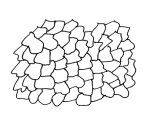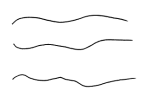Plastics are natural/synthetic materials. They are produced by chemically modifying natural substances or are synthesized from inorganic and organic raw materials. On the basis of their physical characteristics, plastics are usually divided into thermosets, elastomers and thermoplastics. These groups differ primarily with regard to molecular structure, which is what determines their differing thermal behavior. The following Table lists the characteristics of the various types of plastics.
| Type of plastic |
Molecular structure |
Characteristics and applications |
| Thermosets |
 |
Thermosets are hard and have a very tight-meshed, branched molecular structure. Curing proceeds during shaping, after which it is no longer possible to shape the material by heating. Further shaping may then only be performed by machining. Thermosets are used, for example, to make light switches. |
| Elastomers |
 |
While elastomers also have a crosslinked structure, they have a looser mesh than thermosets, giving rise to a degree of elasticity. Once shaped, elastomers also cannot be reshaped by heating. Elastomers are used, for example, to produce automobile tires. |
| Thermoplastics |

 |
Thermoplastics have a linear or branched molecular structure which determines their strength and thermal behavior; they are flexible at ordinary temperatures. At approx. 120 – 180°C, thermoplastics become a pasty/liquid mass. The service temperature range for thermoplastics is considerably lower than that for thermosets. The thermoplastics polyethylene (PE), polyvinyl chloride (PVC) and polystyrene (PS) are used, for example, in packaging applications. |




